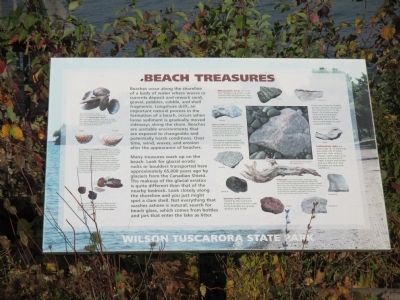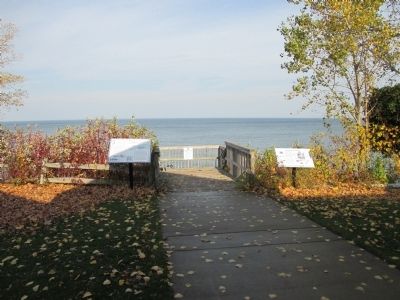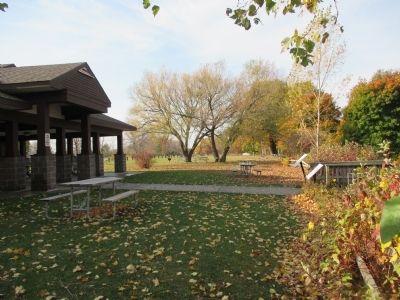Wilson in Niagara County, New York — The American Northeast (Mid-Atlantic)
Beach Treasures
Wilson Tuscarora State Park
Beaches occur along the shoreline of a body of water where waves or currents deposit and rework sand, gravel, pebbles, cobble, and shell fragments. Longshore drift, an important natural process in the formation of a beach, occurs when loose sediment is gradually moved sideways along the shore. Beaches are unstable environments that are exposed to changeable and potentially harsh conditions. Over time, wind, waves, and erosion alter the appearance of beaches.
Many treasures wash up on the beach. Look for rocks or boulders transported here approximately 65,000 years ago by glaciers from the Canadian Shield. The makeup of the glacial erratics is quite different than that of the nearby bedrock. Look closely along the shoreline and you just might spot a clam shell. Not everything that washes ashore is natural; search for beach glass, which comes from bottles and jars that enter the lake as litter.
The most common shells that wash up on the beach here come from freshwater clams. The outer clam shells are dull grey in color for camouflage, but the insides of the shells are lustrous and multi-colored against a pearly white background.
Both zebra and quagga mussels are invasive species. Native to the Caspian Sea, they probably arrived in the United States as stowaways in ballast water of ocean-going ships. Both types of mussels can attach themselves to most submerged, hard surfaces. They cause major problems in power plants and water treatment facilities by clogging pipes, and they damage harbors by attaching themselves to docks, boats, break walls, and bouys. Since zebra mussels and quagga mussels reproduce at a very high rate and have no natural predators, it is difficult to control their populations.
Broken pieces of glass from bottles and jars sometimes end up in the lake. After being churned by water and sand, these fragments become smooth and frosted beach glass.
Metamorphic Rocks are rocks that change composition under intense heat and pressure. Two examples are marble and gneiss.
Glacial erratics are composed of both igneous and metamorphic rocks, primarily granite and gneiss. These rocks are round and are made up of many different materials. Glacial erratics are an attractive combination of white, red, and black colors.
This region's local bedrock consists of sedimentary rocks, mainly dolostone, shale, limestone, and sandstone.
Igneous Rocks are rocks created by the cooling of magma or lava (volcanic rock). Some examples are granite, obsidian, and basalt.
Rocks such as gneiss, marble, granite, obsidian, and basalt are not found here on the beach. Only sedimentary rocks such as limestone, shale,
sandstone, and dolostone can be found here on the beach as well as glacial erratics.
Sedimentary rocks are rocks made up of sediments that settle out of water over time. Over millions of years, while under great pressure, the sediments settle in layers and harden and turn into rock. Two examples are shale and sandstone.
Driftwood is wood from trees, buildings, ships, or wooden objects that has been discarded from the shore and has been washed into a body of water. Over time, the wood decomposes and drifts back on shore where it is often used by birds, plants, and other species for shelter. Many people collect driftwood for outdoor landscapes. Driftwood is also used in fish and reptile tanks.
Erected by Wilson Tuscarora State Park.
Topics. This historical marker is listed in this topic list: Environment.
Location. 43° 18.717′ N, 78° 51.066′ W. Marker is in Wilson, New York, in Niagara County. Marker is on Wilson-Tuscarora State Park Road, 0.2 miles north of Lake Road (New York State Route 18), on the left when traveling east. Marker is behind the facilities building at the top of the staircase to the beach. Marker is on Wilson Tuscarora State Park. Touch for map. Marker is at or near this postal address: 3371 Lake Road, Wilson NY 14172, United States of America. Touch for directions.
Other nearby markers. At least 8 other markers
are within walking distance of this marker. Welcome to Wilson-Tuscarora State Park (here, next to this marker); Lake Shore Rarities (within shouting distance of this marker); Toronto Skyline (about 700 feet away, measured in a direct line); O'Connell Island (approx. 0.6 miles away); A Solemn Tribute to the Men and Women of Wilson who Served (approx. ¾ mile away); Vietnam Memorial in Memory of 1st Lt. Michael E. Witkop (approx. 0.8 miles away); Lake Island Park (approx. 0.8 miles away); Lake Island Park, Wintergreen Island, Tugwell Island & Clark Island (approx. 0.8 miles away). Touch for a list and map of all markers in Wilson.
More about this marker. A vehicle use fee may be required in season.
Also see . . .
1. Wilson-Tuscarora State Park. New York State Office of Parks, Recreation, and Historic Preservation website entry (Submitted on December 10, 2014, by Anton Schwarzmueller of Wilson, New York.)
2. Zebra Mussel. Wikipedia entry:
Invasive species. Updated information including Great Lakes predators of the zebra mussel. (Submitted on December 10, 2014, by Anton Schwarzmueller of Wilson, New York.)
Credits. This page was last revised on January 2, 2022. It was originally submitted on December 10, 2014, by Anton Schwarzmueller of Wilson, New York. This page has been viewed 397 times since then and 14 times this year. Photos: 1, 2, 3. submitted on December 10, 2014, by Anton Schwarzmueller of Wilson, New York. • Bill Pfingsten was the editor who published this page.


